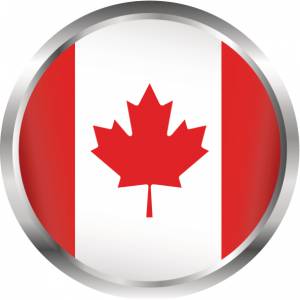Canada’s Maple Leaf Flag Turns 50 this Month
 On Sunday, February 15, 2015 the National Flag of Canada, also called the Maple Leaf, will celebrate its 50th birthday. Prior to the Maple Leaf, the Union Jack (flag of Great Britain) was the official flag of the Canadian people, because Canada was originally a British territory. The Canadian flag features two vertical red panels on either end with an 11 point red maple leaf emblazoned on a white center square. It is twice as long as it is wide.
On Sunday, February 15, 2015 the National Flag of Canada, also called the Maple Leaf, will celebrate its 50th birthday. Prior to the Maple Leaf, the Union Jack (flag of Great Britain) was the official flag of the Canadian people, because Canada was originally a British territory. The Canadian flag features two vertical red panels on either end with an 11 point red maple leaf emblazoned on a white center square. It is twice as long as it is wide.
History
Canada has had many flags over the years. After World War I, the quest for a new flag began in earnest, but it wasn’t until the 1960s that the movement made significant progress. In 1964, new Liberal Prime Minister Lester Pearson, winner of the 1957 Nobel Peace Prize, asked Parliament to appointment a committee to consider alternative flags. One of Pearson’s campaign promises had been to pursue a different flag for the country. Pearson wanted the flag of Canada to stand out and be distinctively Canadian. There were numerous people against the idea and political battles ensued on many fronts. However, in October of 1964, the flag selection committee picked the Maple Leaf over two other shortlisted options.
The origin of the design is still debated; some claim Dr. George Stanley, inspired by the flag of Kingston Royal Military College, deserves the credit and others attribute the Maple Leaf to John Ross Matheson, a Liberal PM. The Canadian Parliament approved the choice the following December and Queen Elizabeth II (also then referred to as the Queen of Canada), proclaimed the new flag in January. It was officially inaugurated and raised for the first time over Parliament on February 15, 1965.
Why the Maple Leaf?
Over the years, the maple leaf has been frequently used as a symbol of Canada. It has been worn on Canadian soldiers’ caps and badges since the 19th century, including during World Wars I and II. The maple leaf was featured on all Canadian coins between 1876 and 1901. Today it can be seen on the penny. Another reason why the maple leaf may have ended up on the flag is that it is relatively easy to draw. Maple leaves are also red in fall and red is one of Canada’s national colors with white being the other.
Fun Facts
- You can own a flag that has flown over Peace Tower and the Canadian Parliament. A Maple Leaf flies over Peace Tower 24 hours a day, but is changed each morning. After a flag is taken down, it is transported to a government office. Employees distribute each Maple Leaf that has been removed to people who have requested them. There is a 10 year waiting list.
- After the 1995 referendum for Quebec Independence was narrowly defeated, government officials gave away a million flags to promote unity. The gesture cost $15 million.
- The Largest Canadian Flag ever made was 40 yards by 83 yards and cost $15,000. It was unveiled at a football game and is too big to ever fly. Eighty pairs of hands were needed to carry it onto the field.
- During Game 2 of the 1992 World Series between the Toronto Blue Jays and Atlanta Braves, the Maple Leaf was held upside down by the U.S. Marine Corps when the national anthems were played during the pregame ceremony. The Blue Jays ended up winning the game, but the incident caused quite a stir. Many Canadian fans retaliated by holding U.S. flags upside down at Game 3 in Toronto.
The 50th birthday of the National Flag of Canada is a big deal and much has changed in Canada since 1965. Hopefully the Maple Leaf will fly over continued peace and prosperity during the next 50 years.

